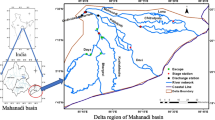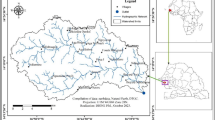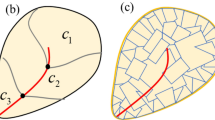Abstract
Annual fluvial and pluvial floods happened in Lower ** River Basin, Thailand. A flood hazard assessment approach was performed in the present study to evaluate flood impacts. The coupled 1D-2D hydrodynamic (HD) modeling package was applied for different return periods to investigate and classify the flood hazards. The 1D hydrodynamic model was calibrated for flood year 2011 at discharge and water level stations. The 2D hydrodynamic model was calibrated using observed flood map. Flood hazards were categorized based on critical flood depths for flooding scenarios of 2-, 5-, 10-, 25-, 50-, and 100-year return periods. The results showed that 28.8% of the total basin area (2423.8 km2) was flooded during the 100-year return period, and the maximum flood inundation area was observed in Kamphaengphet and Nakhon Sawan provinces. Mostly, the flooded area under each return period was categorized under high hazard, followed by low and medium, and the least area was classified under a very high hazard level. More than 40% of sub-districts’ area of Kamphaengphet and Nakhon Sawan provinces were flooded, which is located along the ** River, while less than 20% sub-districts’ area was flooded in Tak Province. The government and local stakeholders need to consider structural and nonstructural measures to reduce flood impacts in three provinces, and priority-based areal flood management approaches should be considered during the implementation of flood mitigation measures.









Similar content being viewed by others
Data availability
Not applicable.
References
Abbott MB, Ionescu F (1967) On the numerical computation of nearly horizontal flows. J Hydraul Res 5(2):97–117. https://doi.org/10.1080/00221686709500195
Ahmadian R, Falconer RA, Jon W (2018) Benchmarking of flood inundation extent using various dynamically linked one- and two-dimensional approaches. J Flood Risk Manag 11:S314–S328. https://doi.org/10.1111/jfr3.12208
Baky MAA, Islam M, Paul S (2019) Flood hazard, vulnerability and risk assessment for different land use classes using a flow model. Earth Syst Environ 4(1):225–244. https://doi.org/10.1007/s41748-019-00141-w
Boonrawd K, Jothityangkoon C (2015) Map** temporal extent of Chiang Mai floods using coupled 1-D and quasi 2-D floodplain inundation models. Songklanakarin J Sci Technol 37(2):171–181
Boonrawd K, Jothityangkoon C (2018) Assessing the climate change impact on floodplain inundation map in the Chiang Mai Municipality, Upper ** River Basin of Thailand. Lowland Technol Int 20(2):213–220
Chaiwongsaen N, Nimnate P, Choowong M (2019) Morphological changes of the Lower ** and Chao Phraya rivers, North and Central Thailand: flood and coastal equilibrium analyses. Open Geosci 11(1):152–171. https://doi.org/10.1515/geo-2019-0013
Cook A, Merwade V (2009) Effect of topographic data, geometric configuration and modeling approach on flood inundation map**. J Hydrol 377(1–2):131–142. https://doi.org/10.1016/j.jhydrol.2009.08.015
Damayanti F (2011) Hydrodynamic modeling for flood hazard assessment in Telomoyo Catchment. Central Java, Indonesia http://www.itc.nl/library/papers_2011/msc/aes/damayanti.pdf
Deltares (1999) User Manual. Delft-3D FLOW. Simulation of multi-dimensional and hydrodynamic phenomena, including sediments. Deltares, The Netherlands, pp 7–8
Deltares (2019) User Manual. SOBEK. Hydrodynamics, rainfall-runoff and real-time control, 1D/2D modelling suite for integrated water solutions. Deltares, The Netherlands, pp 1–3
DHI (2016) User Manual. MIKE 21 flow model. Hørsholm, Denmark, pp 12–14
DHI (2017) Reference Manual. A modeling system for rivers and channels. Hørsholm, Denmark, pp 17–20
EDF (2000) Validation Document. Telemac-2D hydrodynamic model studies, France, pp 14–18
Elfeki A, Masoud M, Niyazi B (2017) Integrated rainfall-runoff and flood inundation modeling for flash flood risk assessment under data scarcity in arid regions: wadi Fatimah basin case study, Saudi Arabia. Nat Hazards 85(1):87–109. https://doi.org/10.1007/s11069-016-2559-7
ESCAP (1991) Manual and guidelines for comprehensive flood loss prevention and management. Bangkok, Thailand
Furman E, Su J, Chen Y, Santoshkumar S, Zhang L (2019) Modeling, Measuring and Pricing Flood Risk , Survey and Actuarial Perspective. Society of Actuaries 5–20
Ghimire S (2013) Application of a 2D hydrodynamic model for assessing flood risk from extreme storm events. Climate 1(3):148–162. https://doi.org/10.3390/cli1030148
Gumbel E J (1941) Probability‐interpretation of the observed return‐periods of floods. Eos, Transactions American Geophysical Union, 22(3):836–850. https://doi.org/10.1029/TR022i003p00836
Iwalewa TM, Elamin AS, Kaka SI (2016) A coupled model simulation assessment of shallow water-table rise in a Saudi Arabian coastal city. J Hydro Environ Res 12:46–58
Jamrussri S, Toda Y (2017) Simulating past severe flood events to evaluate the effectiveness of nonstructural flood countermeasures in the upper Chao Phraya river basin, Thailand. J Hydrol 10(2011):82–94. https://doi.org/10.1016/j.ejrh.2017.02.001
Kadam P, Sen D (2012) Flood inundation simulation in Ajoy River using Mike-Flood. ISH J Hydraulic Eng 18(2):129–141. https://doi.org/10.1080/09715010.2012.695449
Kwak Y, Hasegawa A, Inomata H, Magome J, Fukaml K, Takeuchi K (2011) A new assessment methodology for flood risk: a case study in the Indus river basin. IAHS-AISH Publicat 347(July):55–60
Leandro J, Chen AS, Djordjević S, Savić AD (2009) Comparison of 1d/1d and 1d/2d coupled (sewer/surface) hydraulic models for urban flood simulation. J Hydraul Eng 135(6):495–504. https://doi.org/10.1061/(ASCE)HY.1943-7900.0000037
Mani P, Chatterjee C, Kumar R (2014) Flood hazard assessment with multiparameter approach derived from coupled 1D and 2D hydrodynamic flow model. Nat Hazards 70(2):1553–1574. https://doi.org/10.1007/s11069-013-0891-8
Mapiam PP, Sriwongsitanon N (2009) Estimation of the urbs model parameters for flood estimation of ungauged catchments in the upper ** river basin, Thailand. ScienceAsia 35(1):49–56. https://doi.org/10.2306/scienceasia1513-1874.2009.35.049
Ministry of Natural Resources and Environment (2005) Project develo** watershed management organizations in pilot sub-basins of the ** River Basin, Thailand, pp 22–26
Mokhtar ES, Biswajeet P, Ghazali AH, Shafri HZM (2018) Assessing flood inundation map** through estimated discharge using gis and Hec-Ras model. Arab J Geosci 11(21). https://doi.org/10.1007/s12517-018-4040-2
Mosquera-Machado S, Ahmad S (2007) Flood hazard assessment of Atrato River in Colombia. Water Resour Manag 21(3):591–609. https://doi.org/10.1007/s11269-006-9032-4
Niroshinie MAC, Nihei Y, Ohtsuki K, Kada S (2015) Flood inundation analysis and mitigation with a coupled 1d-2d hydraulic model: a case study in Kochi, Japan. J Disast Res 10(6):1099–1109. https://doi.org/10.20965/jdr.2015.p1099
Nogherotto R, Fantini A, Raffaele F, Di Sante F, Dottori F, Coppola E, Giorgi F (2019) An integrated hydrological and hydraulic modelling approach for the flood risk assessment over Po river basin. Nat Hazards Earth Syst Sci Discuss 2019(November):1–22. https://doi.org/10.5194/nhess-2019-356
New South Wale Government (2005) Floodplain development manual, the management of flood liable land. Department of Infrastructure, Planning and Natural Resources, Sydney, New South Wale, pp 6–10
Oubennaceur K, Chokmanim K, Nastev M, Gauthier Y, Poulin J, Tanguy M, Raymond S, Lhissou R (2019) New sensitivity indices of a 2d flood inundation model using gauss quadrature sampling. Geosciences (Switzerland) 9(5). https://doi.org/10.3390/geosciences9050220
Patra JP, Kumar R, Mani P (2016) Combined fluvial and pluvial flood inundation modeling for a project site. Procedia Technol 24:93–100. https://doi.org/10.1016/j.protcy.2016.05.014
Pelletier JD, Mayer L, Pearthree PA, House PK, Demsey KA, Klawon JK, Vincent KR (2005) An integrated approach to flood hazard assessment on alluvial fans using numerical modeling, field map**, and remote sensing. Geol Soc Am 117(9–10):1167–1180. https://doi.org/10.1130/B25544.1
Peña F, Fernando N (2018) Floodplain terrain analysis for coarse resolution 2D flood modeling. Hydrology 5(4). https://doi.org/10.3390/hydrology5040052
Quirogaa VM, Kurea S, Udoa K, Manoa A (2016) Application of 2d numerical simulation for the analysis of the February 2014 Bolivian Amazonia flood: application of the new Hec-Ras version 5. Ribagua 3(1):25–33. https://doi.org/10.1016/j.riba.2015.12.001
Reda AG, Tripathi NK, Soni P, Tipdecho T, Vaddhanaphuti C, Lanka S (2012) Climate variability in ** River Basin. 4th International Conference of GIT4NDM
Sriwongsitanon N (2010) Flood forecasting system development for the upper ** river basin. Kasetsart J (Nat Sci) 44(4):717–731
Taesombat W, Sriwongsitanon N (2010) Flood investigation in the upper ** river basin using mathematical models. Kasetsart J (Nat Sci) 44(1):152–166
The Ministry of Finance (2011) Thai Flood 2011: rapid assessment for resilient recovery and reconstruction planning. Bangkok, Thailand http://www.gfdrr.org/sites/gfdrr.org/files/publication/Thai_Flood_2011_2.pdf
Tingsanchali T, Karim MF (2005) Flood hazard and risk analysis in the southwest region of Bangladesh. Hydrol Process 19(10):2055–2069. https://doi.org/10.1002/hyp.5666
Tingsanchali T, Karim F (2010) Flood-hazard assessment and risk-based zoning of a tropical floodplain: a case study of the Yom River, Thailand. Hydrol Sci J 55(2):145–161. https://doi.org/10.1080/02626660903545987
Tsakiris G (2014) Flood risk assessment: concepts, modeling, applications. Nat Hazards Earth Syst Sci 14(5):1361–1369. https://doi.org/10.5194/nhess-14-1361-2014
UN. Office of the Disaster Relief Co-Ordinator (UNDRO)(1991) Mitigating natural disasters: Phenomena, effects and options: A manual for policy makers and planners. Nueva York, USA.
US Army Corps of Engineers (US-ACE)(2015) User Manual. HEC-RAS river system analysis. Institute of Water Resources, Hydrologic Engineering Center (HEC), California
Vidyapriya V, Ramalingam M (2016) Flood mitigation study in Adayar river using MIKE-FLOOD. Int J Sci Eng Res 7(7):709–716 http://www.northburnett.qld.gov.au/res/file/flood_mitigation_study_140114.pdf
Acknowledgments
The authors would like to acknowledge the support from Panya Consultants Co., Ltd. Thailand for providing necessary data and technical support throughout the research. The authors would like to thanks the Royal Irrigation Department (RID), Thailand, and Thai Meteorological Department (TMD) for providing the hydrological and meteorological data for the study. The authors would like to extend the word of thanks to the two anonymous reviewers for the constructive comments and suggestions. We would also like to appreciate the contribution of Dr. Rana Ammar Aslam for the improvement of the research article.
Author information
Authors and Affiliations
Contributions
All authors contributed equally.
Corresponding author
Ethics declarations
Conflicts of interest
The authors declare that they have no conflict of interest.
Code availability
Not applicable.
Additional information
Responsible Editor: Broder J. Merkel
Rights and permissions
About this article
Cite this article
Tansar, H., Babur, M. & Karnchanapaiboon, S.L. Flood inundation modeling and hazard assessment in Lower ** River Basin using MIKE FLOOD. Arab J Geosci 13, 934 (2020). https://doi.org/10.1007/s12517-020-05891-w
Received:
Accepted:
Published:
DOI: https://doi.org/10.1007/s12517-020-05891-w




